2007 CHEVROLET CORVETTE instrument panel
[x] Cancel search: instrument panelPage 318 of 488
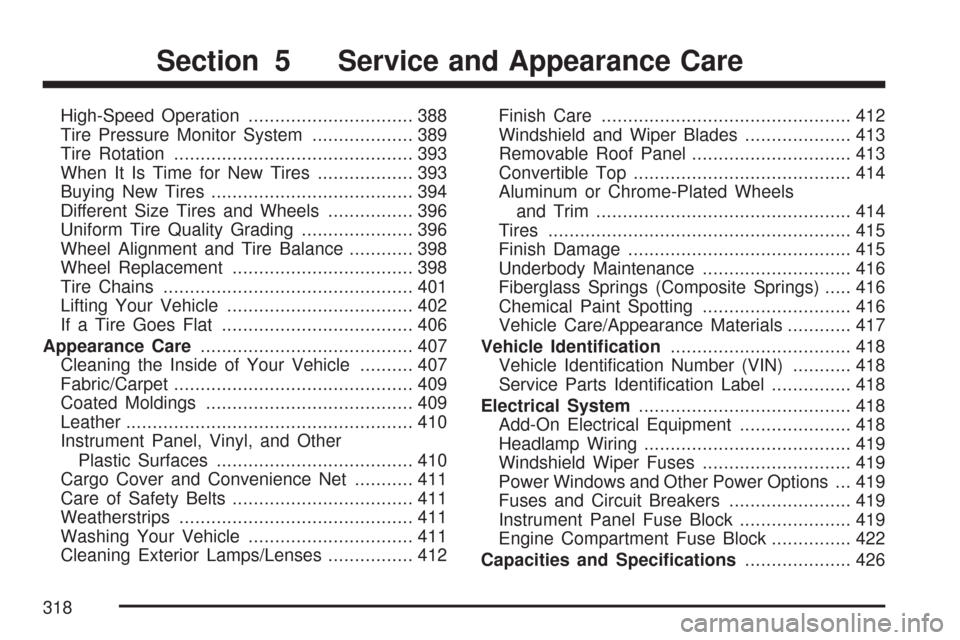
High-Speed Operation............................... 388
Tire Pressure Monitor System................... 389
Tire Rotation............................................. 393
When It Is Time for New Tires.................. 393
Buying New Tires...................................... 394
Different Size Tires and Wheels................ 396
Uniform Tire Quality Grading..................... 396
Wheel Alignment and Tire Balance............ 398
Wheel Replacement.................................. 398
Tire Chains............................................... 401
Lifting Your Vehicle................................... 402
If a Tire Goes Flat.................................... 406
Appearance Care........................................ 407
Cleaning the Inside of Your Vehicle.......... 407
Fabric/Carpet............................................. 409
Coated Moldings....................................... 409
Leather...................................................... 410
Instrument Panel, Vinyl, and Other
Plastic Surfaces..................................... 410
Cargo Cover and Convenience Net........... 411
Care of Safety Belts.................................. 411
Weatherstrips............................................ 411
Washing Your Vehicle............................... 411
Cleaning Exterior Lamps/Lenses................ 412Finish Care............................................... 412
Windshield and Wiper Blades.................... 413
Removable Roof Panel.............................. 413
Convertible Top......................................... 414
Aluminum or Chrome-Plated Wheels
and Trim................................................ 414
Tires......................................................... 415
Finish Damage.......................................... 415
Underbody Maintenance............................ 416
Fiberglass Springs (Composite Springs)..... 416
Chemical Paint Spotting............................ 416
Vehicle Care/Appearance Materials............ 417
Vehicle Identi�cation.................................. 418
Vehicle Identi�cation Number (VIN)........... 418
Service Parts Identi�cation Label............... 418
Electrical System........................................ 418
Add-On Electrical Equipment..................... 418
Headlamp Wiring....................................... 419
Windshield Wiper Fuses............................ 419
Power Windows and Other Power Options ... 419
Fuses and Circuit Breakers....................... 419
Instrument Panel Fuse Block..................... 419
Engine Compartment Fuse Block............... 422
Capacities and Speci�cations.................... 426
Section 5 Service and Appearance Care
318
Page 321 of 488
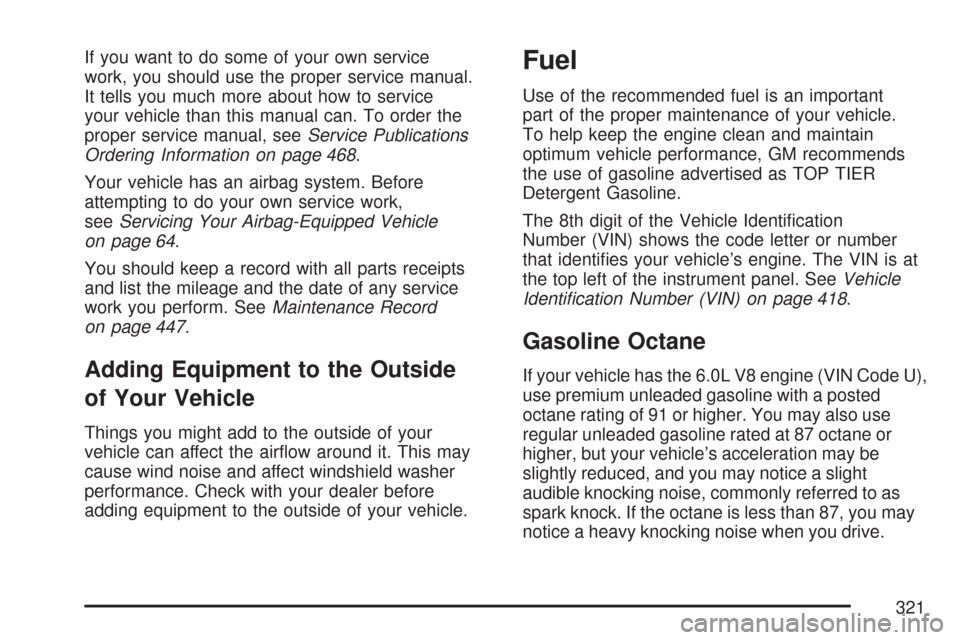
If you want to do some of your own service
work, you should use the proper service manual.
It tells you much more about how to service
your vehicle than this manual can. To order the
proper service manual, seeService Publications
Ordering Information on page 468.
Your vehicle has an airbag system. Before
attempting to do your own service work,
seeServicing Your Airbag-Equipped Vehicle
on page 64.
You should keep a record with all parts receipts
and list the mileage and the date of any service
work you perform. SeeMaintenance Record
on page 447.
Adding Equipment to the Outside
of Your Vehicle
Things you might add to the outside of your
vehicle can affect the air�ow around it. This may
cause wind noise and affect windshield washer
performance. Check with your dealer before
adding equipment to the outside of your vehicle.
Fuel
Use of the recommended fuel is an important
part of the proper maintenance of your vehicle.
To help keep the engine clean and maintain
optimum vehicle performance, GM recommends
the use of gasoline advertised as TOP TIER
Detergent Gasoline.
The 8th digit of the Vehicle Identi�cation
Number (VIN) shows the code letter or number
that identi�es your vehicle’s engine. The VIN is at
the top left of the instrument panel. SeeVehicle
Identi�cation Number (VIN) on page 418.
Gasoline Octane
If your vehicle has the 6.0L V8 engine (VIN Code U),
use premium unleaded gasoline with a posted
octane rating of 91 or higher. You may also use
regular unleaded gasoline rated at 87 octane or
higher, but your vehicle’s acceleration may be
slightly reduced, and you may notice a slight
audible knocking noise, commonly referred to as
spark knock. If the octane is less than 87, you may
notice a heavy knocking noise when you drive.
321
Page 325 of 488
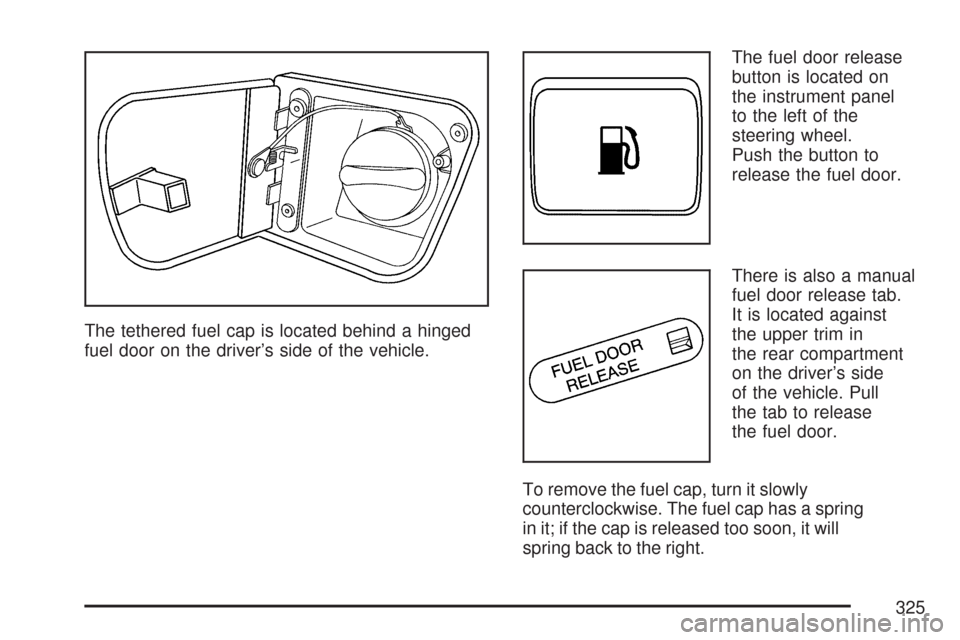
The tethered fuel cap is located behind a hinged
fuel door on the driver’s side of the vehicle.The fuel door release
button is located on
the instrument panel
to the left of the
steering wheel.
Push the button to
release the fuel door.
There is also a manual
fuel door release tab.
It is located against
the upper trim in
the rear compartment
on the driver’s side
of the vehicle. Pull
the tab to release
the fuel door.
To remove the fuel cap, turn it slowly
counterclockwise. The fuel cap has a spring
in it; if the cap is released too soon, it will
spring back to the right.
325
Page 329 of 488
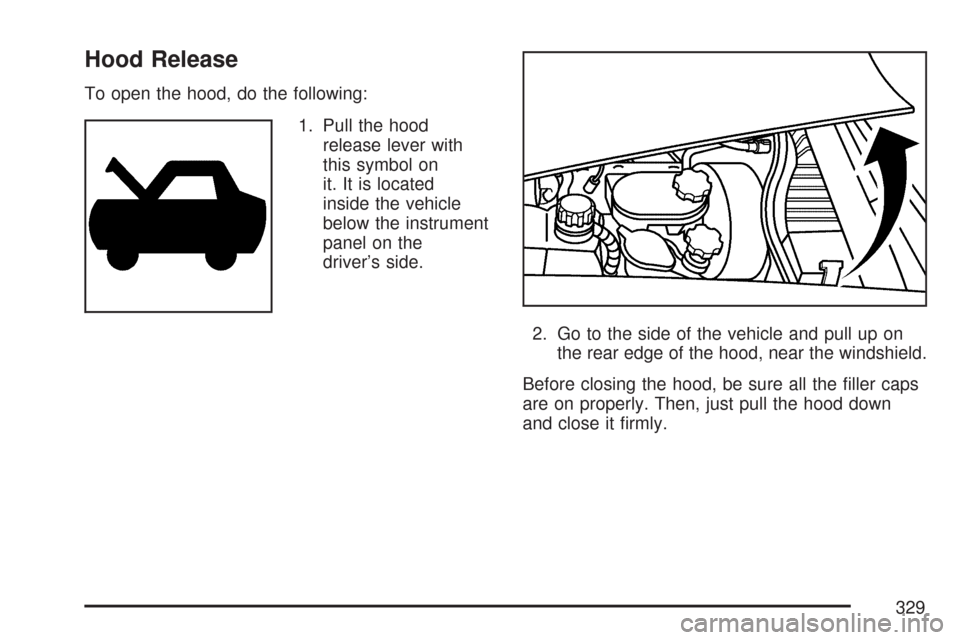
Hood Release
To open the hood, do the following:
1. Pull the hood
release lever with
this symbol on
it. It is located
inside the vehicle
below the instrument
panel on the
driver’s side.
2. Go to the side of the vehicle and pull up on
the rear edge of the hood, near the windshield.
Before closing the hood, be sure all the �ller caps
are on properly. Then, just pull the hood down
and close it �rmly.
329
Page 350 of 488
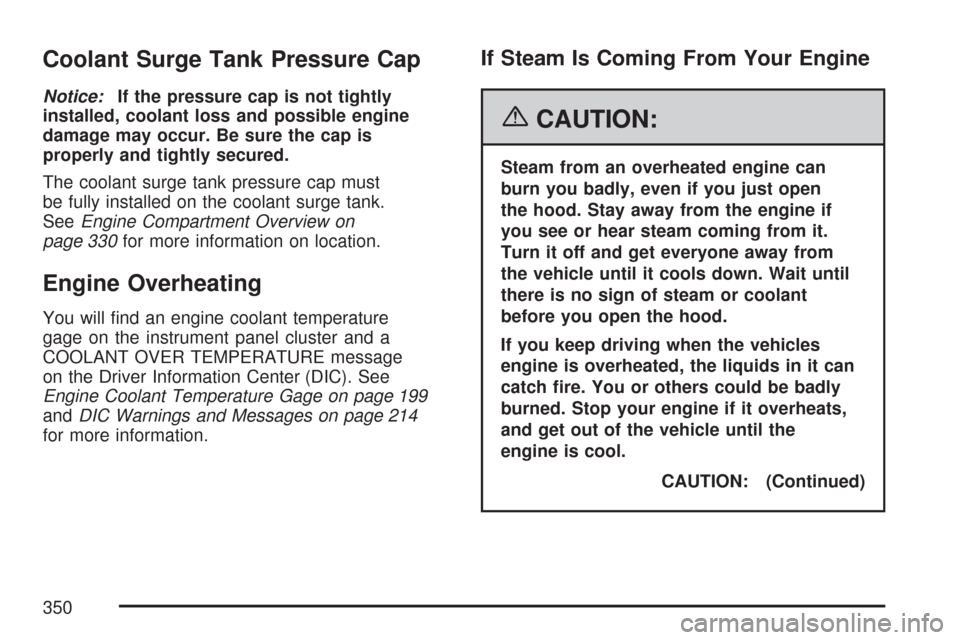
Coolant Surge Tank Pressure Cap
Notice:If the pressure cap is not tightly
installed, coolant loss and possible engine
damage may occur. Be sure the cap is
properly and tightly secured.
The coolant surge tank pressure cap must
be fully installed on the coolant surge tank.
SeeEngine Compartment Overview on
page 330for more information on location.
Engine Overheating
You will �nd an engine coolant temperature
gage on the instrument panel cluster and a
COOLANT OVER TEMPERATURE message
on the Driver Information Center (DIC). See
Engine Coolant Temperature Gage on page 199
andDIC Warnings and Messages on page 214
for more information.
If Steam Is Coming From Your Engine
{CAUTION:
Steam from an overheated engine can
burn you badly, even if you just open
the hood. Stay away from the engine if
you see or hear steam coming from it.
Turn it off and get everyone away from
the vehicle until it cools down. Wait until
there is no sign of steam or coolant
before you open the hood.
If you keep driving when the vehicles
engine is overheated, the liquids in it can
catch �re. You or others could be badly
burned. Stop your engine if it overheats,
and get out of the vehicle until the
engine is cool.
CAUTION: (Continued)
350
Page 389 of 488
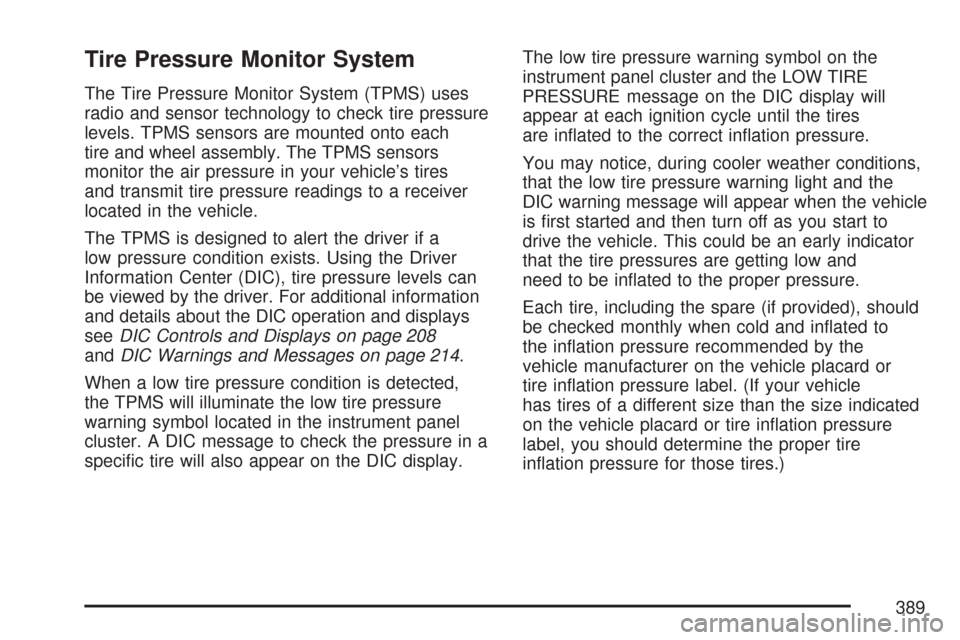
Tire Pressure Monitor System
The Tire Pressure Monitor System (TPMS) uses
radio and sensor technology to check tire pressure
levels. TPMS sensors are mounted onto each
tire and wheel assembly. The TPMS sensors
monitor the air pressure in your vehicle’s tires
and transmit tire pressure readings to a receiver
located in the vehicle.
The TPMS is designed to alert the driver if a
low pressure condition exists. Using the Driver
Information Center (DIC), tire pressure levels can
be viewed by the driver. For additional information
and details about the DIC operation and displays
seeDIC Controls and Displays on page 208
andDIC Warnings and Messages on page 214.
When a low tire pressure condition is detected,
the TPMS will illuminate the low tire pressure
warning symbol located in the instrument panel
cluster. A DIC message to check the pressure in a
speci�c tire will also appear on the DIC display.The low tire pressure warning symbol on the
instrument panel cluster and the LOW TIRE
PRESSURE message on the DIC display will
appear at each ignition cycle until the tires
are in�ated to the correct in�ation pressure.
You may notice, during cooler weather conditions,
that the low tire pressure warning light and the
DIC warning message will appear when the vehicle
is �rst started and then turn off as you start to
drive the vehicle. This could be an early indicator
that the tire pressures are getting low and
need to be in�ated to the proper pressure.
Each tire, including the spare (if provided), should
be checked monthly when cold and in�ated to
the in�ation pressure recommended by the
vehicle manufacturer on the vehicle placard or
tire in�ation pressure label. (If your vehicle
has tires of a different size than the size indicated
on the vehicle placard or tire in�ation pressure
label, you should determine the proper tire
in�ation pressure for those tires.)
389
Page 410 of 488
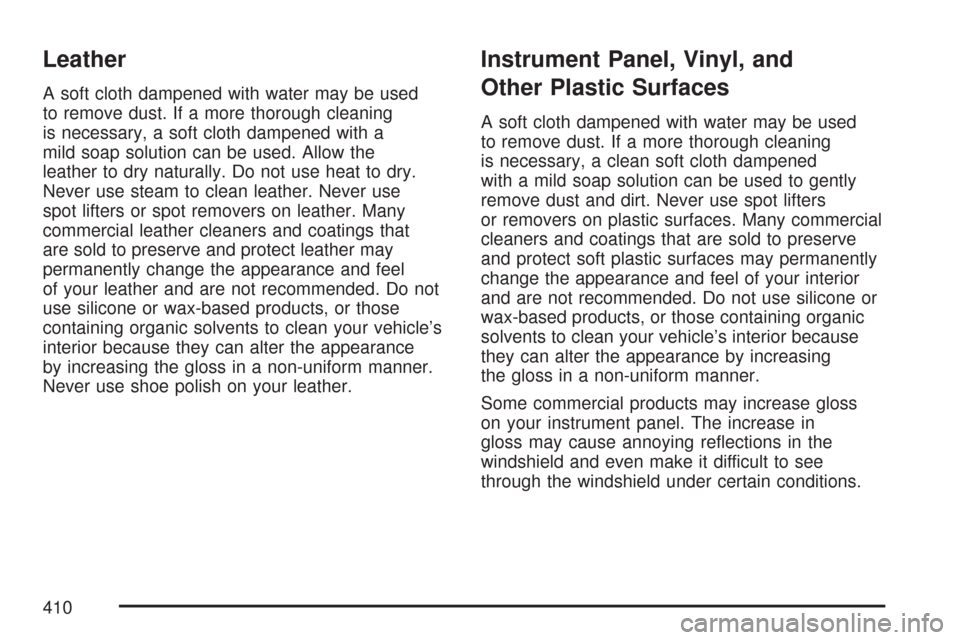
Leather
A soft cloth dampened with water may be used
to remove dust. If a more thorough cleaning
is necessary, a soft cloth dampened with a
mild soap solution can be used. Allow the
leather to dry naturally. Do not use heat to dry.
Never use steam to clean leather. Never use
spot lifters or spot removers on leather. Many
commercial leather cleaners and coatings that
are sold to preserve and protect leather may
permanently change the appearance and feel
of your leather and are not recommended. Do not
use silicone or wax-based products, or those
containing organic solvents to clean your vehicle’s
interior because they can alter the appearance
by increasing the gloss in a non-uniform manner.
Never use shoe polish on your leather.
Instrument Panel, Vinyl, and
Other Plastic Surfaces
A soft cloth dampened with water may be used
to remove dust. If a more thorough cleaning
is necessary, a clean soft cloth dampened
with a mild soap solution can be used to gently
remove dust and dirt. Never use spot lifters
or removers on plastic surfaces. Many commercial
cleaners and coatings that are sold to preserve
and protect soft plastic surfaces may permanently
change the appearance and feel of your interior
and are not recommended. Do not use silicone or
wax-based products, or those containing organic
solvents to clean your vehicle’s interior because
they can alter the appearance by increasing
the gloss in a non-uniform manner.
Some commercial products may increase gloss
on your instrument panel. The increase in
gloss may cause annoying re�ections in the
windshield and even make it difficult to see
through the windshield under certain conditions.
410
Page 418 of 488

Vehicle Identi�cation
Vehicle Identi�cation Number (VIN)
This is the legal identi�er for your vehicle.
It appears on a plate in the front corner of the
instrument panel, on the driver side. You can
see it if you look through the windshield from
outside your vehicle. The VIN also appears on
the Vehicle Certi�cation and Service Parts labels
and the certi�cates of title and registration.
Engine Identi�cation
The eighth character in the VIN is the engine
code. This code helps you identify your vehicle’s
engine, speci�cations, and replacement parts.
Service Parts Identi�cation Label
This label is on the inside of the glove box.
It is very helpful if you ever need to order parts.
The label has the following information:
Vehicle Identi�cation Number (VIN)
Model designation
Paint information
Production options and special equipment
Do not remove this label from the vehicle.
Electrical System
Add-On Electrical Equipment
Notice:Do not add anything electrical to your
vehicle unless you check with your dealer �rst.
Some electrical equipment can damage your
vehicle and the damage would not be covered
by your warranty. Some add-on electrical
equipment can keep other components from
working as they should.
Your vehicle has an air bag system. Before
attempting to add anything electrical to your
vehicle, seeServicing Your Airbag-Equipped
Vehicle on page 64.
418